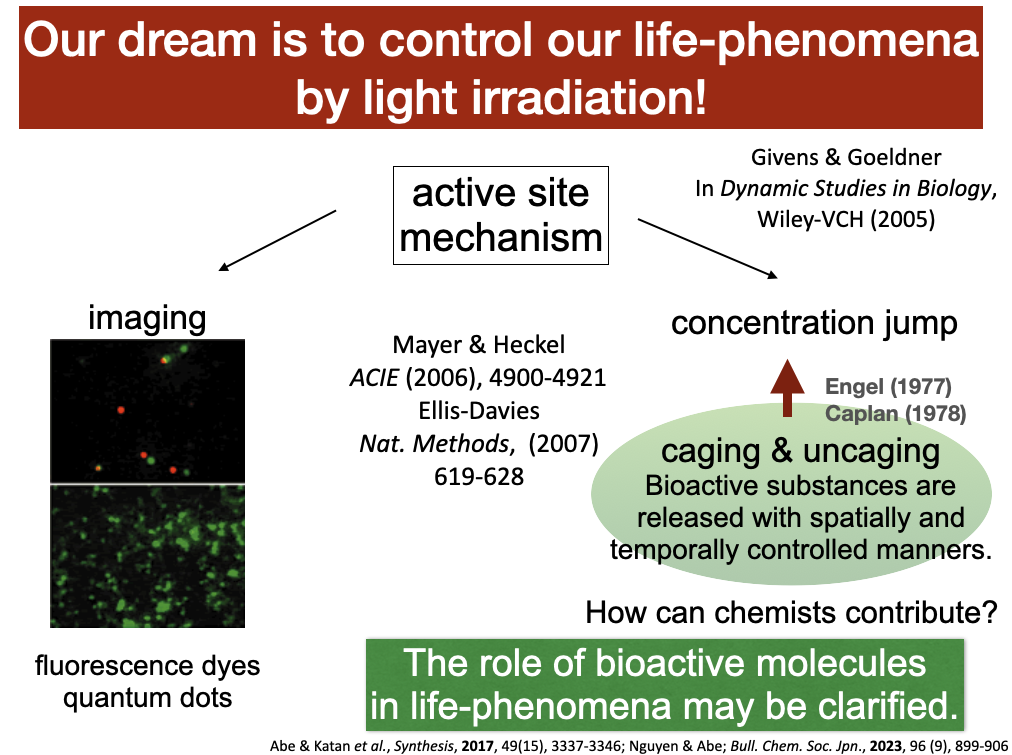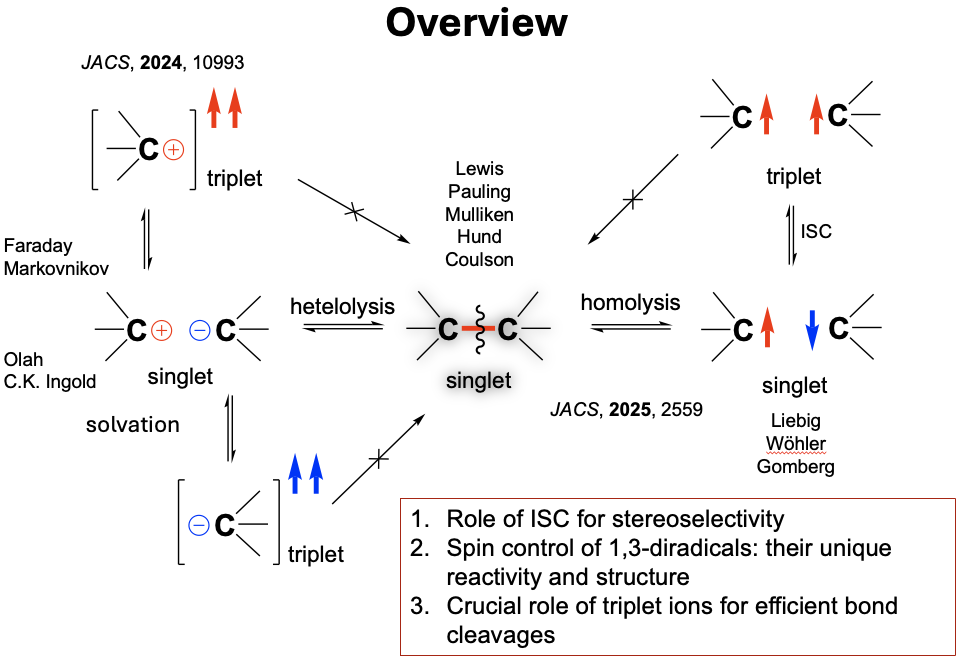
Research-Abe
Caged Compounds

Caged compounds are important reagents in physiological studies, particularly in the field of neuroscience. Spatially and temporally controlled uncaging of neurotransmitters upon photolysis enables a better understanding of in vivo neuronal processes. For example, caged glutamates play a crucial role when studying mammalian learning and memory mechanisms. In engineering these probes, several well-defined properties of caged compounds must be considered. A fast and efficient uncaging of the biologically active molecule is important under irradiation conditions, and thermal stability of caged compounds is required in the physiological environment. However, affording both significant two-photon absorption (TPA) and good water solubility are among the most recent issues for in vivo studies of caged compounds. Using two-photon (near-IR) as opposed to one (UV-vis) allows a deeper penetration depth and reduces scattering in biological tissues, and also reduces optical absorption by endogenous chromophores, causing less photodamage. Thus, the pertinent molecular design and synthesis of new caged compounds, based on chromophores with a high TPA cross-section (in GM), remains a challenge.
In the last two decades, several types of caged glutamates, such as nitrobenzyl-, 7-aminocoumarinyl-, ruthenium-biphenyl-, and carboxymethylnitroindolinyl-caged compounds, have been designed and synthesized for physiological studies. Here are numerous examples (including their reported two-photon uncaging cross-sections,), i.e., N-nitrophenethyloxycarbonyl (Noc-glu), carboxynitrobenzyl (CNB-glu), bromohydroxycoumarin (Bhc-glu, 1 GM/740 nm), methoxynitroindolinyl (MNI-glu, 0.06 GM/740 nm), carboxymethylnitroindolinyl (CDNI-glu, 0.06 GM/720 nm), propylmethoxynitrobiphenyl (PMNB-glu, 0.45 GM/800 nm), ruthenium bipyridine (RuBi, 0.14 GM/800 nm), and bisnitropropylstyrylfluorene (BNSF-glu, 5 GM/800 nm). Recently, we reported the synthesis and photochemical reactivity of caged glutamates with a π-extended coumarin chromophore (HBC-glu) as a photolabile protecting group. We are investigating the design and synthesis of new photolabile protecting groupswith high TPA properties.
Diradical Chemistry: A Case Study of Reactive Intermediate Chemistry

When chemical reactions proceed in a stepwise manner, reaction intermediates always exist on potential energy surfaces between starting compounds and products. The structure and the reactivity of intermediates are quite important for the understanding of chemical reactions. However, the reactive intermediates are, in general, short-lived, so that it is quite difficult to experimentally clarify the chemistry. In the last century, chemists made great efforts to uncover the structure and reactivity of the energetically unstable intermediates such as cations,, anions, radicals,, and carbenes. The results of fundamental research studies have made a great contribution to the significant development in the field of not only mechanistic organic chemistry, but also organic synthesis, materials chemistry, and chemical biology. Since the reactive intermediates are short-lived, a number of analytical methods, including low temperature matrix spectroscopy and the laser flash photolysis technique, have also been developed to directly observe the intermediates. The developments of computational methods which can treat open-shell molecules including excited states are also significant. Thus, the fundamental research studies on reactive intermediates have influenced the development of the peripheral field of science, too. We are focusing on the chemistry of localized diradicals.
Localized diradicals (biradicals) are key intermediates in processes involving the homolytic bond-cleavage and formation reactions in cyclic compounds. There are two spin-multiplicities in the localized diradicals, singlet state (↑↓) and triplet state (↑↑), which are equilibrated with one another by the intersystem crossing process (ISC, a process of the multiplicity change). The chemistry of triplet diradicals is well-investigated not only as reactive intermediates, but also in materials chemistry, because the triplet diradicals frequently have lifetimes long enough to allow the diradicals to be detected under low temperature matrix conditions and are characterized using conventional spectroscopic techniques such as the EPR (Electron Paramagnetic Resonance) method. The paramagnetic character of triplet diradicals makes them potential building blocks for organic magnets and other materials with novel properties. Thus, the chemistry of triplet diradicals is very rich and the high-spin property has attracted continuous interest in many fields of chemistry. On the other hand, the singlet state of localized diradicals had been recognized as putative (undetectable) intermediates, because the intramolecular radical-radical coupling reactions are supposed to be barrier-less processes. In contrast to the rich chemistry of triplet diradicals, thus, the chemistry of localized singlet diradicals has been studied less, especially in experiments. It was necessary to generate detectable singlet diradicals, before thorough studies on the reactive intermediates were possible. The fundamental research studies on the hitherto unknown character of localized singlet diradicals was expected to provide not only new insights into the mechanisms of intramolecular homolytic reactions, but also opportunities to discover new concepts and novel functions of molecules.
